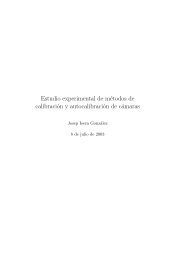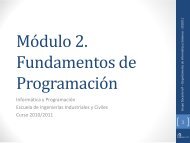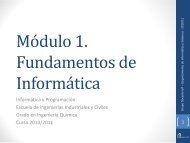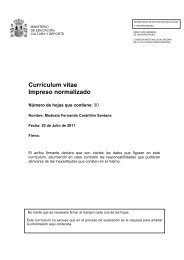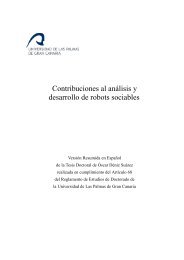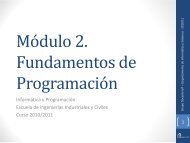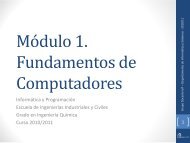PhD Document - Universidad de Las Palmas de Gran Canaria
PhD Document - Universidad de Las Palmas de Gran Canaria
PhD Document - Universidad de Las Palmas de Gran Canaria
Create successful ePaper yourself
Turn your PDF publications into a flip-book with our unique Google optimized e-Paper software.
CHAPTER 2. THE CASE OF SOCIAL ROBOTICS<br />
contrary, autistic savants would be able to access raw information 1 .<br />
Figure 2.2: Children can not i<strong>de</strong>ntify the couple sharing sexual intimacy (right) because they<br />
lack prior memory associated with such scenario. They can see nine dolphins (left).<br />
Representative of this theory is the case of the autistic savant child Nadia [Selfe, 1977].<br />
At about three and a half years, Nadia could draw natural images with great <strong>de</strong>tail, without<br />
training. She could draw a horse with amazing <strong>de</strong>tail and perspective. Normal children<br />
aged four drew the horse with much less fi<strong>de</strong>lity, usually si<strong>de</strong>-on and with rough ellipses<br />
representing the main body parts. Normal children drew according to their mental schema,<br />
Nadia drew what she saw. Another astonishing example of this theory is represented in Tem-<br />
ple <strong>Gran</strong>din [<strong>Gran</strong>din, 1995, <strong>Gran</strong>din and Scariano, 1986], an autistic but highly functional<br />
person, who has an extraordinary visual intelligence. She herself points out that she stores<br />
information in his head as if it were a CD-ROM disk. Her thought patterns work with spe-<br />
cific examples, while normal people move from the general concept to specific examples.<br />
Often, she struggles to comprehend things that people consi<strong>de</strong>r evi<strong>de</strong>nt.<br />
The reason that leads us to associate autistic savants with computers/robots sheds<br />
light as to what makes a robot be observed as such. Typically, we tend to think in terms of<br />
what could make a machine more human-like. Here, the approach is to think in terms of what<br />
1 Recently, a <strong>de</strong>ficit in the activity of "mirror neurons" (MN) has been linked to autism (see<br />
[Williams et al., 2001] for example). MNs are active when monkeys perform certain tasks, but they also fire<br />
when the monkeys watch someone else perform the same specific task. A similar mechanism has been indirectly<br />
observed in healthy humans, but not at the same level in autistic people. Note that, essentially, the<br />
phenomenon involves two different perceptions that are "unified" at a neurological level. Such unification may<br />
be indicative of the formation or use of the concept ("hand-waving", for example). An explanation based on a<br />
difficulty in working with concepts at a conscious level (instead of the <strong>de</strong>tailed perceptions) would also account<br />
for this phenomenon as a particular case.<br />
14



